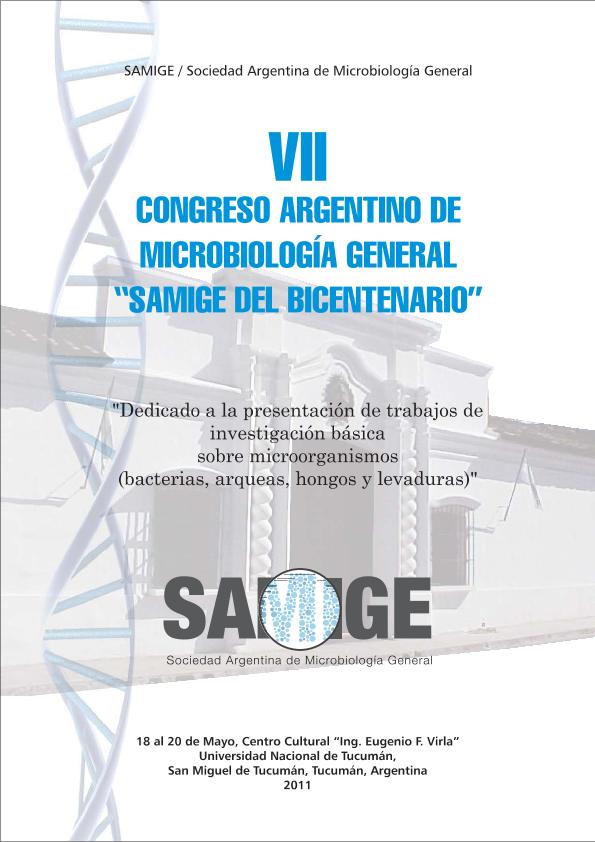Mostrar el registro sencillo del ítem
dc.contributor.author
Bourguignon, Natalia

dc.contributor.author
Cuozzo, Sergio Antonio

dc.contributor.author
Benimeli, Claudia Susana

dc.contributor.author
Fuentes, María Soledad

dc.contributor.author
Amoroso, Maria Julia del R.

dc.date.available
2023-04-17T09:48:38Z
dc.date.issued
2011
dc.identifier.citation
Aerobic removal of methoxichlor contaminated soil by Streptomyces sp. A14; VII Congreso Argentino de Microbiología General; San Miguel de Tucumán; Argentina; 2011; 1-2
dc.identifier.uri
http://hdl.handle.net/11336/194024
dc.description.abstract
Organochlorine pesticides (OP) have aroused global concern due to their long persistence, low biodegradability, wide range distribution in the environment and chronic adverse effect on wildlife and humans. Methoxychlor (MTX) is a toxic OP that was used in industrial and agricultural activities and for the malaria control. Although the use of MTX has been internationally banned it can still be detected in the environment like in the northwest of Argentina. Bioremediation offers the possibility to environment cleanup of pollutants, such as OP, using natural biological activity. However, there is little information available about microbial MTX degradation. Actinobacteria have a great potential for bioremediation of toxic compounds, in addition strains of Streptomyces genus may be well suited for soil inoculation as a consequence of their mycelial growth habit, relatively rapid rates of growth and colonization of semi-selective substrates. In our laboratory, we isolated an actinobacteria strain from OP-contaminated soil in Santiago del Estero, Argentina, identified as Streptomyces sp. A14, able to remove and degrade MTX from liquid minimal medium. Thus, the purpose of this work is to contribute to the study of bioremediation of MTX by actinobacteria in contaminated soils. Glass pots were filled with 80 g of soil at 20% moisture. The soil samples were sterilized and the soil humidity was adjusted with sterile water and a MTX solution for different final concentrations (8.30 and 16.60 mg kg -1 wet weight (ww) soil). For soil samples inoculation, the microorganism was precultured in Tripticase Soya Broth with MTX (1.66 mg L-1). Soil samples pots with MTX and without MTX as control, were inoculated with Streptomyces sp. A14 (2 g kg-1 ww soil). Soil pots were incubated at 30 ºC for 28 days. Samples were taken each 7 days. The growth was measured as CFU kg-1 and residual MTX from soil was determined by gas chromatography. Our results indicate no significant differences in the growth at the different MTX concentrations added and in the control without MTX. The cell concentration increased up to 2 log units and the maximum growth of Streptomyces sp. A14 was 1.78 x 107 CFU g-1 ww soil, at 14 days of incubation. In both concentration assayed the microorganism was able to remove the soil pesticide, reaching the maximum removal percentages (36.14 and 76.02%) at 28 days of incubation. Finally, we suggest that Streptomyces sp. A14 has a big potential for bioremediation of soils contaminated with high MTX concentrations.
dc.format
application/pdf
dc.language.iso
eng
dc.publisher
Sociedad Argentina de Microbiología
dc.rights
info:eu-repo/semantics/openAccess
dc.rights.uri
https://creativecommons.org/licenses/by-nc-sa/2.5/ar/
dc.subject
METHOXICHLOR
dc.subject
STREPTOMYCES
dc.subject
SOIL
dc.subject
REMOVAL
dc.subject.classification
Biotecnología Medioambiental

dc.subject.classification
Biotecnología del Medio Ambiente

dc.subject.classification
INGENIERÍAS Y TECNOLOGÍAS

dc.title
Aerobic removal of methoxichlor contaminated soil by Streptomyces sp. A14
dc.type
info:eu-repo/semantics/publishedVersion
dc.type
info:eu-repo/semantics/conferenceObject
dc.type
info:ar-repo/semantics/documento de conferencia
dc.date.updated
2023-04-04T12:24:59Z
dc.journal.pagination
1-2
dc.journal.pais
Argentina

dc.journal.ciudad
Ciudad Autónoma de Buenos Aires
dc.description.fil
Fil: Bourguignon, Natalia. Consejo Nacional de Investigaciones Científicas y Técnicas. Centro Científico Tecnológico Conicet - Tucumán. Planta Piloto de Procesos Industriales Microbiológicos; Argentina
dc.description.fil
Fil: Cuozzo, Sergio Antonio. Consejo Nacional de Investigaciones Científicas y Técnicas. Centro Científico Tecnológico Conicet - Tucumán. Planta Piloto de Procesos Industriales Microbiológicos; Argentina
dc.description.fil
Fil: Benimeli, Claudia Susana. Consejo Nacional de Investigaciones Científicas y Técnicas. Centro Científico Tecnológico Conicet - Tucumán. Planta Piloto de Procesos Industriales Microbiológicos; Argentina
dc.description.fil
Fil: Fuentes, María Soledad. Consejo Nacional de Investigaciones Científicas y Técnicas. Centro Científico Tecnológico Conicet - Tucumán. Planta Piloto de Procesos Industriales Microbiológicos; Argentina
dc.description.fil
Fil: Amoroso, Maria Julia del R.. Consejo Nacional de Investigaciones Científicas y Técnicas. Centro Científico Tecnológico Conicet - Tucumán. Planta Piloto de Procesos Industriales Microbiológicos; Argentina
dc.relation.alternativeid
info:eu-repo/semantics/altIdentifier/url/https://samige.org.ar/wp-content/uploads/2022/10/Libro-SAMIGE-2011.pdf
dc.conicet.rol
Autor

dc.conicet.rol
Autor

dc.conicet.rol
Autor

dc.conicet.rol
Autor

dc.conicet.rol
Autor

dc.coverage
Nacional
dc.type.subtype
Congreso
dc.description.nombreEvento
VII Congreso Argentino de Microbiología General
dc.date.evento
2011-05-18
dc.description.ciudadEvento
San Miguel de Tucumán
dc.description.paisEvento
Argentina

dc.type.publicacion
Book
dc.description.institucionOrganizadora
Sociedad Argentina de Microbiología
dc.source.libro
VII Congreso Argentino de Microbiología General
dc.date.eventoHasta
2011-05-20
dc.type
Congreso
Archivos asociados
